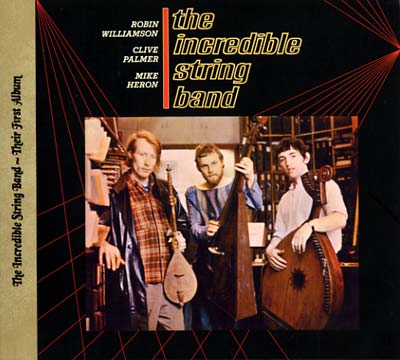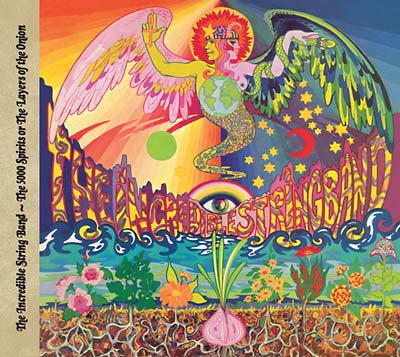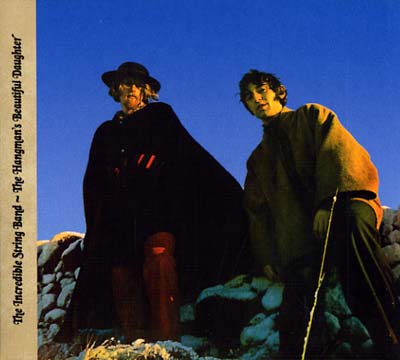
The Incredible String Band CD (FLED 3076CD)
The glorious 1966 Elektra debut LP by the The Incredible String Band. Although rumors have persisted of an earlier demo-only private LP, no studio recordings have surfaced predating this protean session, recorded by Joe Boyd. At this time the band was a trio comprised of Clive Palmer, Robin Williamson and Mike Heron. Palmer was a peripatetic legend, having busked with Wizz Jones in Paris in the late ‘50s before wending his way to Edinburgh with his banjo in 1962. Performing at a club hosted by Archie Fisher (another legendary figure on the Scottish folk scene), Palmer met Williamson, who was also interested in traditional music. They played as a duo until 1965, when they added Mike Heron, who’d been in a series of Edinburgh rock bands (Saracens, Abstracts), but who was interested in changing his errant ways.
The resulting trio made its home at Clive’s Incredible Folk Club and took their (tongue in cheek) name from the same venue. Joe Boyd, fresh from Harvard, charged with starting up an English version of Elektra, had earlier seen the Clive and Robin duo. When he heard about the new trio he rushed back to Edinburgh and signed them away from Transatlantic, who were reportedly ready to pounce.
Boyd produced this eponymous debut and it is a gorgeous blend of traditional elements and hints of the smoky future that was just around the corner. The tunes are mostly originals by Williamson and Heron, and they broadcast a sweet natured grasp of basics, both American and Anglo-Scot, interlaced with wisps of the exotic scents and harmonic approaches they’d explore more fully later in their trajectory.
The album was voted Melody Maker’s folk album of the year, but the trio broke up almost as soon as the sessions were finished. Palmer left for Afghanistan, Williamson took off for Morocco, and Heron stayed in Edinburgh, joining another rock band. But that wasn’t the end of the story. Far from it. This album is but the first step on a brick path leading into the pure heart of hippiedom.

The 5000 Spirits Or The Layers Of The Onion CD (FLED 3077CD)
The second ISB album, regarded by many as a peak moment in the evolution of the British psychedelic underground. Following the release of the band’s trio debut in the summer of 1966, Clive Palmer had split for Afghanistan, Robin Williamson had taken his girlfriend, Licorice McKechnie, to Morocco for an open-ended stay, and Mike Heron had opted to stay in Edinburgh. Heron returned to playing rock music, but in late 1966, Williamson came back from Marrakesh, bearing a wealth of strange North African musical instruments, and an equal number of compositional ideas.
Before long, the two had reformed the ISB as a duo, and they soon began woodshedding in a rural Scottish cottage. Joe Boyd, who had produced the first LP, had started a new club in London called the UFO, in partnership with John “Hoppy” Hopkins (the founder of The International Times). Boyd felt the scene was boiling over and was convinced the ISB had their part to play. He visited the pair, suggesting he become their manager and that they record a second album. The sessions for The 5000 Spirits Or The Layers Of The Onion happened at John Wood’s London studio in late spring 1967, and featured the lovely bass work of Danny Thompson (who had joined Pentangle two months earlier), the vocals of Licorice, and guest spots for “Hoppy”’s piano and Nazir Jairazbhoy’s sitar.
The album was released to great fanfare in July, 1967, just as the ISB was returning from an appearance at the Newport Folk Festival. With its uber-psych cover art by Dutch design firm The Fool (then being envied for their work with The Beatles), and classic songs (traditional folk, swathed in kaftans, incense and finger cymbals), 5000 Layers was truly a record for its time. Hailed by everyone from John Peel to Paul McCartney, the album went to Number One on the UK folk charts, and was an omnipresent accessory in every student garret. Four-plus decades on, it remains one of the all-time readymade classics of the ‘60s.
Interestingly, its original UK catalogue number follows directly upon AMM’s debut LP. AMM and ISB were the first two bands Boyd chose to sign from the hordes of available musicians. That should tell you something.

The Hangman’s Beautiful Daughter CD (FLED 3078CD)
The third ISB album, which many fanboys (and the women who love them) pick as the best album this lovely combo ever issued. By the end of 1967, when this session was recorded, the duo ISB were wildly popular in England and were also becoming well known throughout the international hippie underground. The ruralist vibe Hangman projects so mightily was very much in keeping with the mood enveloping the whole scene in 1968, as the imagined dreams of the previous year were seen to be going to hell in a bucket. People were fleeing the cities, imagining some new life in the woods or the deserts or the caves. The Hangman’s Beautiful Daughter beckoned them with open arms.
Released in March 1968, the album in many ways revolves around Mike Heron’s expansive composition, “A Very Cellular Song.” Taking advantage of some of the new recording tropes afforded by advances in studio technology, Joe Boyd and John Wood helped the band create a sprawling, layered, multi-part suite that always sounded so amazingly perfect on acid, I can’t even begin to tell you. Listening to “Cellular” was like hearing different songs playing in separate nearby rooms, while someone spun you around slowly with your eyes blindfolded. Part Pinder Family hymn (learned from The Real Bahamas), part Sikh spiritual, part late night smoke session, the piece unrolls like some epic tapestry with a different goddamn unicorn shown every couple of feet. I still feel like I’m tripping when I listen to it now, even though I can acknowledge some of its component parts are sheer cornpone. Who cares? But my favorite Hangman tune remains “The Minotaur Song,” which has some of the gooniest-yet-appealing leaps of hippie logic ever recorded.
Licorice appears again on this session, as does David Snell (a great jazzy British harpist), and also the legendary Dolly Collins on flute organ and piano. Boyd had recently produced The Power of the True Love Knot for Dolly and her sister, Shirley. And Collins’ additions are lovely (although subtle amidst the head-gush of the basic duo’s multifarious thrusting). There are also rumors that Richard Thompson lent his pipes to vocals on “The Minotaur Song,” but there’s no mention of it here, so who knows? 5000 Layers got close to the top of the UK rock charts and Robert “Bob” Plant has long maintained that, in their early days, the lads of Led Zeppeloon spent many hours trying to decode the moves within. Zep succeeded in figuring out a couple. But the best ones eluded them. The goons.

Wee Tam & The Big Huge 2CD (FLED 3079CD)
The fourth album by The Incredible String Band is generally the final one fans are able to unreservedly recommend to the uninitiated, although there are certainly ecstatic moments scattered throughout every recording that bears the ISB name. For some reason, it was released as two separate LPs in the U.S.; in the rest of the universe it was issued as a two LP set, and so it is here – Wee Tam & The Big Huge.
Recorded in 1968, as their popularity was peaking, the band by this point had more or less stabilized to quartet form with Williamson, Heron and Licorice being joined by Heron’s then-girlfriend, Rose Simpson, on violin and percussion. They were touring a lot at this point throughout Europe and the U.S., which I assume is how they fell in with the Scientologists, but that particular tragedy doesn’t have any noticeable effect on this album.
There seems to be a certain hermeticism at work on Wee Tam, at least partially because it’s the first time since their debut they recorded without any outside musicians. The songs are a little bit longer in general, and the Scottish folk influence feels as though it’s becoming more distant. Perhaps this was also a function of traveling to the U.S. – as Joe Boyd infers in his liner notes – but one gets the impression the ISB’s musical language is becoming an in-house slang which only they are fully able to decipher.
Elements of earlier sessions are present in terms of sonic detail, but the presentation on Wee Tam feels somehow more domestic and insular. Psychedelic, yeah, but in a way that only relies on earth tones. Some parts remind me of things that Geoff Muldaur and Jim Kweskin were doing around this time and that may well be intentional. Regardless, this contains some of the band’s most bravura recordings – “You Get Brighter,” “Maya,” ‘The Mountain of God,” “The Circle Is Unbroken,” – and it truly deserves a place in the household of every goddamn hippie out there. Won’t you help?
|